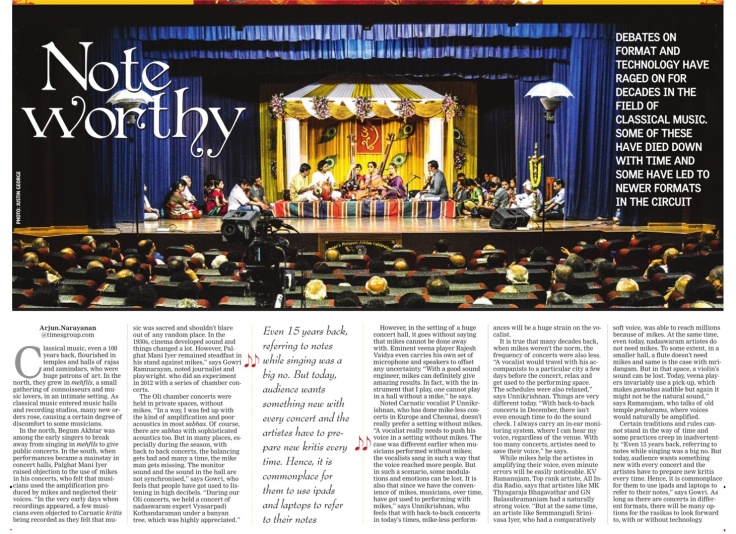
Classical music, even a 100 years back, flourished in temples and halls of rajas and zamindars, who were huge patrons of art. In the north, they grew in mehfils, a small gathering of connoisseurs and music lovers, in an intimate setting. As classical music entered music halls and recording studios, many new orders rose, causing a certain degree of discomfort to some musicians.
In the north, Begum Akhtar was among the early singers to break away from singing in mehfils to give public concerts. In the south, when performances became a mainstay in concert halls, Palghat Mani Iyer raised objection to the use of mikes in his concerts, who felt that musicians used the amplification produced by mikes and neglected their voices. “In the very early days when recordings appeared, a few musicians even objected to Carnatic kritis being recorded as they felt that mu sic was sacred and shouldn’t blare out of any random place. In the 1930s, cinema developed sound and things changed a lot. However, Palghat Mani Iyer remained steadfast in his stand against mikes,” says Gowri Ramnarayan, noted journalist and playwright. who did an experiment in 2012 with a series of chamber concerts.
The Oli chamber concerts were held in private spaces, without mikes. “In a way, I was fed up with the kind of amplification and poor acoustics in most sabhas. Of course, there are sabhas with sophisticated acoustics too. But in many places, especially during the season, with back to back concerts, the balancing gets bad and many a time, the mike man gets missing. The monitor sound and the sound in the hall are not synchronised,” says Gowri, who feels that people have got used to listening in high decibels. “During our Oli concerts, we held a concert of nadaswaram expert Vyasarpadi Kothandaraman under a banyan tree, which was highly appreciated.” However, in the setting of a huge concert hall, it goes without saying that mikes cannot be done away with. Eminent veena player Rajesh Vaidya even carries his own set of microphone and speakers to offset any uncertainty . “With a good sound engineer, mikes can definitely give amazing results. In fact, with the instrument that I play, one cannot play in a hall without a mike,“ he says.
Noted Carnatic vocalist P Unnikrishnan, who has done mike-less concerts in Europe and Chennai, doesn’t really prefer a setting without mikes. “A vocalist really needs to push his voice in a setting without mikes. The case was different earlier when musicians performed without mikes; the vocalists sang in such a way that the voice reached more people. But in such a scenario, some modulations and emotions can be lost. It is also that since we have the convenience of mikes, musicians, over time, have got used to performing with mikes,” says Unnikrishnan, who feels that with back-to-back concerts in today’s times, mike-less perform ances will be a huge strain on the vocalist.
It is true that many decades back, when mikes weren’t the norm, the frequency of concerts were also less. “A vocalist would travel with his accompanists to a particular city a few days before the concert, relax and get used to the performing space.The schedules were also relaxed,” says Unnikrishnan. Things are very different today . “With back-to-back concerts in December, there isn’t even enough time to do the sound check. I always carry an in-ear monitoring system, where I can hear my voice, regardless of the venue. With too many concerts, artistes need to save their voice,“ he says.
While mikes help the artistes in amplifying their voice, even minute errors will be easily noticeable. KV Ramanujam, Top rank artiste, All India Radio, says that artistes like MK Thyagaraja Bhagavathar and GN Balasubramaniam had a naturally strong voice. “But at the same time, an artiste like Semmangudi Srinivasa Iyer, who had a comparatively soft voice, was able to reach millions because of mikes. At the same time, even today, nadaswaram artistes do not need mikes. To some extent, in a smaller hall, a flute doesn’t need mikes and same is the case with mridangam. But in that space, a violin’s sound can be lost. Today, veena players invariably use a pick-up, which makes gamakas audible but again it might not be the natural sound,” says Ramanujam, who talks of old temple prakarams, where voices would naturally be amplified.
Certain traditions and rules cannot stand in the way of time and some practices creep in inadvertently. “Even 15 years back, referring to notes while singing was a big no. But today, audience wants something new with every concert and the artistes have to prepare new kritis every time. Hence, it is commonplace for them to use ipads and laptops to refer to their notes,” says Gowri. As long as there are concerts in different formats, there will be many options for the rasikas to look forward to, with or without technology.
This article was published in The Times of India, Chennai, in 2014

Leave a comment